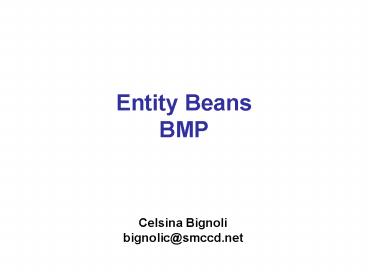Entity Beans BMP - PowerPoint PPT Presentation
1 / 16
Title:
Entity Beans BMP
Description:
home interface exposes finder methods to find entity beans ... 1: ejbStore() 2: ejbPassivate() Business Method. 1: ejbCreate() 2: ejbPostCreate() ejbRemove ... – PowerPoint PPT presentation
Number of Views:70
Avg rating:3.0/5.0
Title: Entity Beans BMP
1
Entity BeansBMP
Celsina Bignoli bignolic_at_smccd.net
2
Entity Beans
- Represent persistent objects saved to permanent
storage - bank account, employee data, etc
- lifetime is completely independent from the user
session - have an identity, used to pass references between
applications and share entities with other clients
3
Entity Beans (2)
- advantages
- compact representation
- can associate methods
- can use implicit middleware services from an
application server - can be cached for performance
4
Persistence
- Object-relational mapping
- save an object to a relational database table
- use JDBC to map the object data into a relational
database - read data from the database and load it into the
fields of a object instance - more sophisticated than Java serialization
- can take advantage of SQL query capabilities
- mapping can be handcrafted or facilitated using
a object-relational mapping tool like Oracle
TopLink or Hibernate
5
Entity Bean Features
- survive failures
- they are just representation of data in a
fault-tolerant storage - have a lifetime much longer than a client session
- they are a view into a database
- they should not be seen as a separate version of
the data in the database - the EJB container maintains the in memory data
and the data in the database in sync using the
ejbLoad() and ejbStore() methods implemented by
the entity bean class
6
Entity Bean Features(2)
- multiple instances represent same data
- one instance servicing multiple requests would
require multi-threading but this would lead to
complex, error-prone implementations - one instance servicing one request at a time
would create bottlenecks - several in-cache instances represent same
underlying database data must solve possible data
corruption - container must synchronize instances periodically
using ejbLoad() and ejbStore() methods - the frequency of the synchronization is dictated
by transactions
7
Entity Bean Features(3)
- instances can be pooled
- entity bean objects are recyclable
- the container may pool and reuse instances to
represent different entries in the underlying
data storage - more efficient
- must acquire and release resources no longer in
use using ejbActivate() and ejbPassivate()
methods - ejbPassivate entails a state save (ejbSave())
- ejbActivate entails a state load (ejbLoad())
8
How to Persist Entity Beans
- bean-managed persistence
- developer must write code to load, save and find
data from data storage - must use persistence API such as JDBC
- container-managed persistence
- strip the bean from any persistence logic
- inform the container how youd like the data to
be persisted using container tools - container generates automatically the persistence
code
9
Creating an Entity Bean
EJB Container
1 create()
Home Object
Client Code
2ejbCreate()
6 return EJB object
Entity Bean Instance
5 create EJB object
4return Primary Key
EJB Object
3 create database data
Database
10
Destroying an Entity Bean
EJB Container
Home Object
2ejbRemove()
1 remove()
Entity Bean Instance
Client Code
EJB Object
1 remove()
2ejbRemove()
3 remove database data
Database
11
Finding Entity Beans
- since entity beans are persisted to data storage
they can be found (unlike session beans, which
only live for the duration of a client session) - home interface exposes finder methods to find
entity beans - session beans do not have finder methods
12
Bean-managed Persistent (BMP) Entity Beans
- developer must write code to map the entity bean
to and from storage - Can use
- a database API such as JDBC
- a object/relation mapping framework (TopLink or
Hibernate) - usually, preferred to Container-managed
persistent (CMP) entity beans ONLY when
performance is an issue
13
BMP Entity Bean Coding Basics
- must implement the javax.ejb.EntityBean interface
javax.ejbEnterpriseBean
javax.ejb.EntityBean void
setEntityContext(javax.ejb.EntityContext) void
unsetEntityContext() void ejbRemove() void
ejbActivate() void ejbPassivate() void
ejbLoad() void ejbStore()
14
BMP Entity Bean Coding Basics (2)
- must define finder methods ejbFindltgt() in the
local and remote home interfaces - must implement finder methods in the bean
implementation to find an existing entity bean in
storage - Must define at least one finder method
ejbFindByPrimaryKey()
15
Entity Bean Files
- remote/local interface
- the enterprise bean class
- maps to an entity in a database (table). An
instance maps to a row in a table - exposes callback methods used by the container to
manage the bean - exposes methods to update fields
- primary key class
- uniquely identifies each bean
- must be serializable
- deployment descriptor
16
BMP Life cycle
does not exist
1 newInstance() 2 setEntityContext()
1 unsetEntityContext() 2 JVM will garbage
collect and call finalize()
pooled
ejbHome()
ejbFind()
1 ejbActivate() 2 ejbLoad()
1 ejbCreate() 2 ejbPostCreate()
1 ejbStore() 2 ejbPassivate()
ejbRemove()
ready
ejbLoad()
ejbStore()
Business Method

